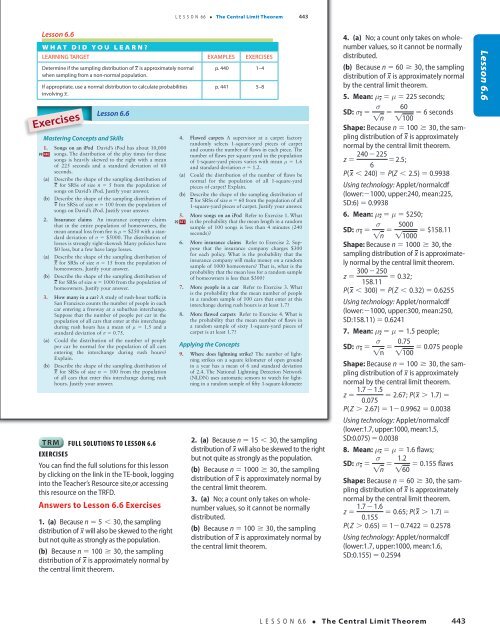SPA 3e_ Teachers Edition _ Ch 6
You also want an ePaper? Increase the reach of your titles
YUMPU automatically turns print PDFs into web optimized ePapers that Google loves.
L E S S O N 6.6 • The Central Limit Theorem 443<br />
Lesson 6.6<br />
18/08/16 5:04 PMStarnes_<strong>3e</strong>_CH06_398-449_Final.indd 443<br />
WhAT DiD y o U LeA rn?<br />
LEARNINg TARgET EXAMPLES EXERCISES<br />
Determine if the sampling distribution of x is approximately normal<br />
when sampling from a non-normal population.<br />
If appropriate, use a normal distribution to calculate probabilities<br />
involving x.<br />
Exercises<br />
Mastering Concepts and Skills<br />
1. Songs on an iPod David’s iPod has about 10,000<br />
songs. The distribution of the play times for these<br />
songs is heavily skewed to the right with a mean<br />
of 225 seconds and a standard deviation of 60<br />
seconds.<br />
(a) Describe the shape of the sampling distribution of<br />
x for SRSs of size n 5 5 from the population of<br />
songs on David’s iPod. Justify your answer.<br />
(b) Describe the shape of the sampling distribution of<br />
x for SRSs of size n 5 100 from the population of<br />
songs on David’s iPod. Justify your answer.<br />
2. Insurance claims An insurance company claims<br />
that in the entire population of homeowners, the<br />
mean annual loss from fire is m 5 $250 with a standard<br />
deviation of s 5 $5000. The distribution of<br />
losses is strongly right-skewed: Many policies have<br />
$0 loss, but a few have large losses.<br />
(a) Describe the shape of the sampling distribution of<br />
x for SRSs of size n 5 15 from the population of<br />
homeowners. Justify your answer.<br />
(b) Describe the shape of the sampling distribution of<br />
x for SRSs of size n 5 1000 from the population of<br />
homeowners. Justify your answer.<br />
3. How many in a car? A study of rush-hour traffic in<br />
San Francisco counts the number of people in each<br />
car entering a freeway at a suburban interchange.<br />
Suppose that the number of people per car in the<br />
population of all cars that enter at this interchange<br />
during rush hours has a mean of m 5 1.5 and a<br />
standard deviation of s 5 0.75.<br />
(a) Could the distribution of the number of people<br />
per car be normal for the population of all cars<br />
entering the interchange during rush hours?<br />
Explain.<br />
(b) Describe the shape of the sampling distribution of<br />
x for SRSs of size n 5 100 from the population<br />
of all cars that enter this interchange during rush<br />
hours. Justify your answer.<br />
pg 440<br />
Lesson 6.6<br />
TRM full Solutions to Lesson 6.6<br />
Exercises<br />
You can find the full solutions for this lesson<br />
by clicking on the link in the TE-book, logging<br />
into the Teacher’s Resource site,or accessing<br />
this resource on the TRFD.<br />
Answers to Lesson 6.6 Exercises<br />
1. (a) Because n = 5 < 30, the sampling<br />
distribution of x will also be skewed to the right<br />
but not quite as strongly as the population.<br />
(b) Because n = 100 ≥ 30, the sampling<br />
distribution of x is approximately normal by<br />
the central limit theorem.<br />
p. 440 1–4<br />
p. 441 5–8<br />
4. Flawed carpets A supervisor at a carpet factory<br />
randomly selects 1-square-yard pieces of carpet<br />
and counts the number of flaws in each piece. The<br />
number of flaws per square yard in the population<br />
of 1-square-yard pieces varies with mean m 5 1.6<br />
and standard deviation s 5 1.2.<br />
(a) Could the distribution of the number of flaws be<br />
normal for the population of all 1-square-yard<br />
pieces of carpet? Explain.<br />
(b) Describe the shape of the sampling distribution of<br />
x for SRSs of size n 5 60 from the population of all<br />
1-square-yard pieces of carpet. Justify your answer.<br />
5. More songs on an iPod Refer to Exercise 1. What<br />
pg 441 is the probability that the mean length in a random<br />
sample of 100 songs is less than 4 minutes (240<br />
seconds)?<br />
6. More insurance claims Refer to Exercise 2. Suppose<br />
that the insurance company charges $300<br />
for each policy. What is the probability that the<br />
insurance company will make money on a random<br />
sample of 1000 homeowners? That is, what is the<br />
probability that the mean loss for a random sample<br />
of homeowners is less than $300?<br />
7. More people in a car Refer to Exercise 3. What<br />
is the probability that the mean number of people<br />
in a random sample of 100 cars that enter at this<br />
interchange during rush hours is at least 1.7?<br />
8. More flawed carpets Refer to Exercise 4. What is<br />
the probability that the mean number of flaws in<br />
a random sample of sixty 1-square-yard pieces of<br />
carpet is at least 1.7?<br />
Applying the Concepts<br />
9. Where does lightning strike? The number of lightning<br />
strikes on a square kilometer of open ground<br />
in a year has a mean of 6 and standard deviation<br />
of 2.4. The National Lightning Detection Network<br />
(NLDN) uses automatic sensors to watch for lightning<br />
in a random sample of fifty 1-square-kilometer<br />
18/08/16 5:04 PM<br />
2. (a) Because n = 15 < 30, the sampling<br />
distribution of x will also be skewed to the right<br />
but not quite as strongly as the population.<br />
(b) Because n = 1000 ≥ 30, the sampling<br />
distribution of x is approximately normal by<br />
the central limit theorem.<br />
3. (a) No; a count only takes on wholenumber<br />
values, so it cannot be normally<br />
distributed.<br />
(b) Because n = 100 ≥ 30, the sampling<br />
distribution of x is approximately normal by<br />
the central limit theorem.<br />
4. (a) No; a count only takes on wholenumber<br />
values, so it cannot be normally<br />
distributed.<br />
(b) Because n = 60 ≥ 30, the sampling<br />
distribution of x is approximately normal<br />
by the central limit theorem.<br />
5. Mean: m x = m = 225 seconds;<br />
SD: s x = s !n = 60<br />
!100 = 6 seconds<br />
Shape: Because n = 100 ≥ 30, the sampling<br />
distribution of x is approximately<br />
normal by the central limit theorem.<br />
240 − 225<br />
z = = 2.5;<br />
6<br />
P( x < 240) = P(Z < 2.5) = 0.9938<br />
Using technology: Applet/normalcdf<br />
(lower:21000, upper:240, mean:225,<br />
SD:6) 5 0.9938<br />
6. Mean: m x = m = $250;<br />
SD: s x = s !n = 5000<br />
!1000 = $158.11<br />
Shape: Because n = 1000 ≥ 30, the<br />
sampling distribution of x is approximately<br />
normal by the central limit theorem.<br />
300 − 250<br />
z =<br />
158.11 = 0.32;<br />
P( x < 300) = P( Z < 0.32) = 0.6255<br />
Using technology: Applet/normalcdf<br />
(lower:21000, upper:300, mean:250,<br />
SD:158.11) 5 0.6241<br />
7. Mean: m x = m = 1.5 people;<br />
SD: s x = s !n = 0.75 = 0.075 people<br />
!100<br />
Shape: Because n = 100 ≥ 30, the sampling<br />
distribution of x is approximately<br />
normal by the central limit theorem.<br />
1.7 − 1.5<br />
z = = 2.67; P( x > 1.7) =<br />
0.075<br />
P( Z > 2.67) = 1− 0.9962 = 0.0038<br />
Using technology: Applet/normalcdf<br />
(lower:1.7, upper:1000, mean:1.5,<br />
SD:0.075) 5 0.0038<br />
8. Mean: m x = m = 1.6 flaws;<br />
SD: s x = s !n = 1.2 = 0.155 flaws<br />
!60<br />
Shape: Because n = 60 ≥ 30, the sampling<br />
distribution of x is approximately<br />
normal by the central limit theorem.<br />
1.7 − 1.6<br />
z = = 0.65; P( x > 1.7) =<br />
0.155<br />
P( Z > 0.65) = 1− 0.7422 = 0.2578<br />
Using technology: Applet/normalcdf<br />
(lower:1.7, upper:1000, mean:1.6,<br />
SD:0.155) 5 0.2594<br />
Lesson 6.6<br />
L E S S O N 6.6 • The Central Limit Theorem 443<br />
Starnes_<strong>3e</strong>_ATE_CH06_398-449_v3.indd 443<br />
11/01/17 3:58 PM




